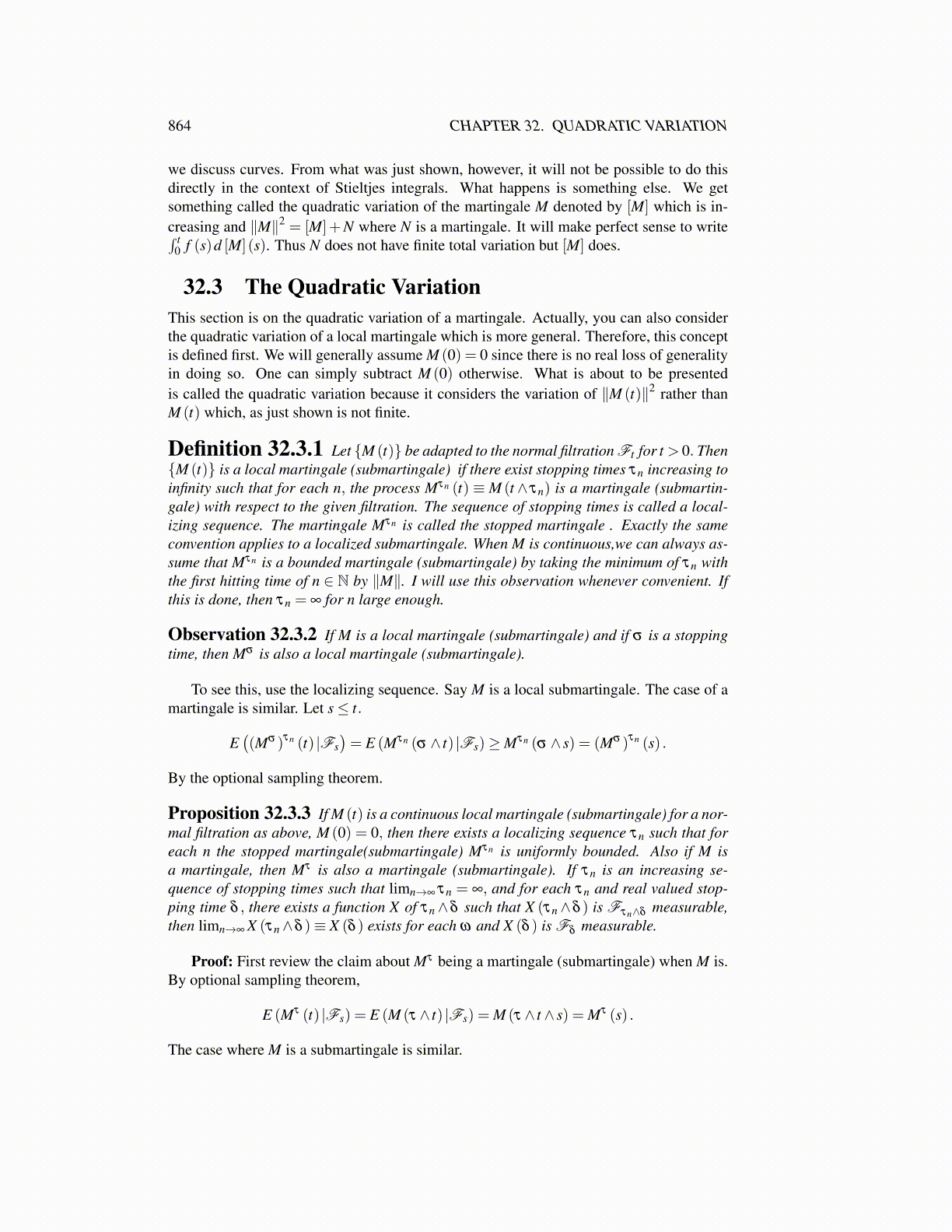
864 CHAPTER 32. QUADRATIC VARIATION
we discuss curves. From what was just shown, however, it will not be possible to do thisdirectly in the context of Stieltjes integrals. What happens is something else. We getsomething called the quadratic variation of the martingale M denoted by [M] which is in-creasing and ∥M∥2 = [M]+N where N is a martingale. It will make perfect sense to write∫ t
0 f (s)d [M] (s). Thus N does not have finite total variation but [M] does.
32.3 The Quadratic VariationThis section is on the quadratic variation of a martingale. Actually, you can also considerthe quadratic variation of a local martingale which is more general. Therefore, this conceptis defined first. We will generally assume M (0) = 0 since there is no real loss of generalityin doing so. One can simply subtract M (0) otherwise. What is about to be presentedis called the quadratic variation because it considers the variation of ∥M (t)∥2 rather thanM (t) which, as just shown is not finite.
Definition 32.3.1 Let {M (t)} be adapted to the normal filtration Ft for t > 0. Then{M (t)} is a local martingale (submartingale) if there exist stopping times τn increasing toinfinity such that for each n, the process Mτn (t) ≡M (t ∧ τn) is a martingale (submartin-gale) with respect to the given filtration. The sequence of stopping times is called a local-izing sequence. The martingale Mτn is called the stopped martingale . Exactly the sameconvention applies to a localized submartingale. When M is continuous,we can always as-sume that Mτn is a bounded martingale (submartingale) by taking the minimum of τn withthe first hitting time of n ∈ N by ∥M∥. I will use this observation whenever convenient. Ifthis is done, then τn = ∞ for n large enough.
Observation 32.3.2 If M is a local martingale (submartingale) and if σ is a stoppingtime, then Mσ is also a local martingale (submartingale).
To see this, use the localizing sequence. Say M is a local submartingale. The case of amartingale is similar. Let s≤ t.
E((Mσ )τn (t) |Fs
)= E (Mτn (σ ∧ t) |Fs)≥Mτn (σ ∧ s) = (Mσ )τn (s) .
By the optional sampling theorem.
Proposition 32.3.3 If M (t) is a continuous local martingale (submartingale) for a nor-mal filtration as above, M (0) = 0, then there exists a localizing sequence τn such that foreach n the stopped martingale(submartingale) Mτn is uniformly bounded. Also if M isa martingale, then Mτ is also a martingale (submartingale). If τn is an increasing se-quence of stopping times such that limn→∞ τn = ∞, and for each τn and real valued stop-ping time δ , there exists a function X of τn∧δ such that X (τn∧δ ) is Fτn∧δ measurable,then limn→∞ X (τn∧δ )≡ X (δ ) exists for each ω and X (δ ) is Fδ measurable.
Proof: First review the claim about Mτ being a martingale (submartingale) when M is.By optional sampling theorem,
E (Mτ (t) |Fs) = E (M (τ ∧ t) |Fs) = M (τ ∧ t ∧ s) = Mτ (s) .
The case where M is a submartingale is similar.